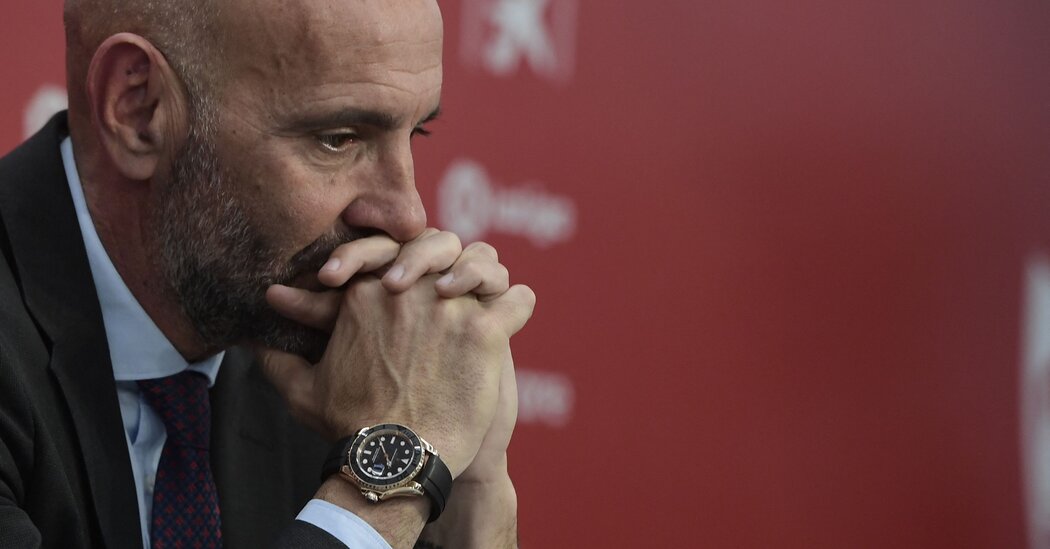Udinese knew about Alexis Sánchez long before he had been called up to play for the Chilean national team. It knew about him before he had played in the Copa Libertadores, before the rest of South America discovered him and before he had caught the acquisitive eyes of Europe’s biggest, richest teams.
Quite how much time elapsed between Sánchez’s making his debut — a substitute appearance for Cobreloa, a team based in the mining town of Calama in Chile’s parched, dusty north — and word of his talent spreading all the way from the edge of the Atacama Desert to Italy’s cold, foggy northeast is difficult to establish precisely.
A couple of months, possibly. Maybe less. There is a chance that Udinese knew about Sánchez even before, on April 23, 2005, Jawed Karim stood outside the elephant enclosure at the San Diego Zoo, filming himself for a website he had helped to launch.
It was not especially compelling content. “The cool thing about these guys,” Karim said, correctly, “is that they have really, really, really long trunks.” It may not have been David Attenborough, but it was the first video uploaded to YouTube. And it would, ultimately, be possibly the most significant event in Udinese’s modern history.
A middleweight sort of a club in Serie A, Udinese did not have the luxury of employing a scout on the ground in Chile, one who could attend mid-table Primera División games in the hopes of unearthing a generational talent. Instead, it found out about Sánchez the way it found out about almost all of the dozens of nascent stars it had discovered.
Under the auspices of Gino Pozzo, the son of the club’s owner, Udinese had spent years establishing a formidable, informal network of contacts across the globe: coaches, fixers, scouts, agents, journalists.
The emphasis was not on countries that were well established as sources of players — Brazil, Argentina, Portugal, the Netherlands — but on those places that were a little more off the beaten track: the Czech Republic, Slovenia, Colombia, Chile. “We look in countries where there is a good balance between the technical level and the financial,” Pozzo told The Times of London in 2015.
Under the Pozzos’ setup, if any of Udinese’s informants spotted a player who might be of interest, they would send footage — in the form of videotape, initially, and then DVDs — to the club. In Italy, it would be parsed and analyzed by Udinese’s technical staff. If the recommendation passed muster, the club would dispatch scouts to watch the player in person.
For more than a decade, the system worked, and it worked spectacularly. Udinese earned a reputation as masters of the transfer market, the most reliable talent merchants in Italy. Márcio Amoroso, Marek Jankulovski, Sulley Muntari and Oliver Bierhoff all passed through Udine on their way to grander, brighter horizons.
So did Sánchez, whose career after Italy took him to Barcelona, Arsenal, Manchester United and — after a brief loan spell with Inter Milan — to Marseille. He was a totem in what may well be the finest national team Chile has known. There is an argument, a convincing one, that he is his country’s greatest player.
He was also, though neither he nor the club knew it at the time, the last hurrah of Udinese’s golden era.
The way Udinese worked, of course, never wavered. Pozzo’s attempts to expand his empire — he invested in the Spanish team Granada and the English club Watford in an attempt to industrialize Udinese’s recruitment strategy — failed, but he still had his network of contacts around the world. Thousands upon thousands of hours of tape still poured into the club’s viewing center. Udinese did not lose its expertise, its judgment, its way.
And yet it rapidly found its edge dulled nonetheless. While Udinese had not changed, the rest of the world had. Both the technology that YouTube pioneered and the principle it represented — that footage of anything could be uploaded and quickly disseminated online — had not taken long to infiltrate soccer.
Clubs no longer needed to have a dedicated scout covering a league to find players. Instead, they could track a competition on one of any number of video-sharing platforms that offered game footage for a reasonable monthly fee. The most prominent, Wyscout, became a compulsory subscription for every club. Soon, data providers added video to their packages, too. Now, if it knew what it was looking for, any team could be Udinese.
Soccer has a habit of undervaluing these sorts of cultural shifts, and as a result misunderstanding the currents that eddy and swirl around it, invisibly and inexorably shaping its reality. There is a tendency, for example, to berate the sport for its apparent reluctance to embrace data as quickly as baseball and, to some extent, basketball.
The charge is that soccer’s inherent conservatism, its aversion to new thinking, conditioned it to resist the benefits of analytics. That is, doubtless, true. But in researching “Expected Goals,” my book on the history of the relationship between soccer and data, it became clear that before 1998, and the invention of the DVD, even attempting any form of analytics was too unwieldy to be practical. One of the pioneers of the field, ProZone, initially used a system that required eight — eight — interconnected VCRs in order to annotate tape.
That blindness to the indirect, external factors that explain success is significant. This month, Aston Villa appointed Ramón Rodriguez Verdejo — better known as Monchi — as its president of football operations. It is, doubtless, a coup. Monchi has, in almost two decades at Sevilla, established himself as one of the most admired talent spotters in world soccer.
Monchi’s track record is unparalleled. He has discovered so many players — Ivan Rakitic, Carlos Bacca, Jules Koundé, countless others — that the profits from their sales helped transform Sevilla from a financially stricken, second-division team into one that can win the Europa League even when it expressly does not want to win the Europa League.
The only note of caution, when Monchi’s appointment by Villa was announced, was that it is not yet clear if his skills are transferable. He left Sevilla once before, for the Italian side Roma, and lasted less than a year. (The reasons behind that premature departure are intensely debated and fervently held.)
Perhaps, though, there should be another warning. Monchi’s calling card, his pièce de résistance, was his signing of Dani Alves, two decades ago. The Brazilian fullback, currently awaiting trial in Spain on charges of sexual assault, went on to play for Barcelona, Juventus and Paris St.-Germain. No player has won more honors. He made 126 appearances for Brazil. His signing was the beginning of Monchi’s legend.
The story of how Monchi found him, though, is significant. Sevilla spotted Alves at the South American under-20 championship, when he stood out so much that Sevilla’s scout called Monchi immediately, praising this young right back to the skies. The haste was, perhaps, unnecessary. Sevilla was the only European club to have sent a representative to the tournament.
That is not to say that Monchi is outdated. He thrived in Seville for two decades. He is no starchy traditionalist. He has been more than willing to innovate and experiment and update his methods. He is impeccably connected, fiercely intelligent, a consummate deal maker: precisely the sort of executive, in other words, that an ambitious team like Villa needs.
But it is true that, since returning to Sevilla from Roma in 2019, Monchi’s success rate has been just a little lower. Koundé, now with Barcelona, is the only relatively recent addition to his greatest hits. The others, from Alves to Rakitic to the forwards Luís Fabiano and Júlio Baptista, all now belong to a previous era of the game.
Like Udinese, it is not that Monchi has changed. It is not even that he has suffered the fate of so many pioneers, and found his advantage eroded by imitation. It is simply that everyone can now send a scout to the South American under-20 championship. And even if they do not, they can always watch the games on Wyscout or Scout7, or read the data on StatsBomb or Opta Pro or InStat.
The world has changed, in other words. It was altered irrevocably by “Me at the zoo,” even if it did not know it at the time. The executives in charge of world soccer know that now, of course. But knowing it, and figuring out how that should influence the decisions you make and the things you believe: Those are two quite different things.
Caesar’s Wife
At best, the evidence is circumstantial. It may be nothing more than coincidence.
To recap the bare facts of the case, because it is all quite dry and convoluted and also requires an inelegant number of the uses of the word “fund”: Clearlake, the private equity firm that owns Chelsea — alongside the transfer market master strategist Todd Boehly — has received some (it’s not clear how much) investment from the Public Investment Fund, Saudi Arabia’s sovereign wealth fund.
The PIF, as previously discussed in this newsletter, recently took control of four teams in the Saudi Pro League, and has set about hiring a glut of aging, slightly faded stars to populate them. Many of its targets, as it turns out, play for Chelsea: N’Golo Kanté, Hakim Ziyech, Pierre-Emerick Aubameyang and so on.
As it happens, Chelsea has spent colossal sums on players since Clearlake and Boehly took over last year. It now finds itself desperately trying to pare down its bloated, expensive squad, both for practical reasons — the players do not all fit in one changing room — and more pressing economic ones: Chelsea needs its books to balance a little more by the end of the month so the club doesn’t run afoul of various financial regulations put in place by the Premier League and European soccer.
On the surface, then, it is not hard to understand why people might think this Saudi buying of Chelsea players is all just a little too convenient. Somewhere along the line, the people doing the buying and the people doing the selling have interests that are, let’s say, mutually aligned.
There is, of course, an alternative explanation: that Chelsea has a stock of high-profile players it no longer requires, and that the Saudi authorities — working out how to spend the PIF’s money — have spotted an opportunity, in essence, to buy in bulk. Coincidence, in other words. Nothing untoward to see here at all, just the usual mechanics of the market.
And that may well be true. Certainly, those involved with Chelsea and the Saudi clubs insist that it is. But that does not mean the perception is not a problem. Saudi Arabia’s bailing Chelsea out of a mess of the club’s own making would compromise soccer’s integrity. Saudi Arabia merely looking as if it is bailing out Chelsea, though, is not a whole lot better.
In his trilogy on the Roman orator and politician Cicero, the author Robert Harris depicts the story of Publius Clodius Pulcher, a sociopathic, rabble-rousing politician who slips into Julius Caesar’s home to witness the rites of the Good Goddess, a ceremony only women were permitted to attend.
Clodius is caught. A scandal, and a trial, ensue. Caesar insists he did not allow Clodius to enter, and nor did his wife, Pompeia. He maintains her innocence absolutely, in fact. But he is the chief of the official Roman state religion, the pontifex maximus. And so he divorces Pompeia. What matters most of all, he realizes, is not just that his wife — and his family — “are free from guilt, but even from the suspicion of it.”
Correspondence
A great sin was committed in last week’s newsletter, and thankfully — with the unerring precision of a Luis Suárez free kick, or a pod of orcas attacking a boat — Tom Karsay spotted it immediately. In the story of Luciano Spalletti, I did not so much as bury the lede as omit it altogether. “His car,” Tom wrote. “Did he ever get it back?”
The answer is, pleasingly, that he got some of it back: Once Spalletti announced that he was leaving Napoli, a delegation of the club’s ultras presented him with the car’s steering wheel, as a goodbye gift. Personally, I am in favor of this becoming a tradition: Departing managers should in perpetuity be presented at Napoli with a steering wheel in gratitude for their service.
Mary Irene Katsibas spotted another absence. “Writing about managers walking away before they are fired I wish you had mentioned Zidane,” she pointed out, entirely reasonably. Zinedine Zidane knew when to call it a day at Real Madrid. The first time round, at least. He did kind of spoil it by going back and having to leave again, though.
And Eduardo Frias has a response to the question, posed last week, about who will benefit most from Lionel Messi’s arrival in Major League Soccer, outside his new teammates at Inter Miami. “Argentina’s national team,” Eduardo wrote, definitively. “Messi happy, staying in shape, playing in a league where they will not try to break his ankles in every challenge is a huge plus.”
That, without question, was part of the motivation behind Messi’s choice: Though he recently hinted otherwise, I think we can probably assume that Messi is intending to defend the World Cup — on what by then will be home soil — in 2026. Now what was that thing about legacy being defined by knowing when to walk away …
Rory Smith is The Times’s chief soccer correspondent, based in Britain. He covers all aspects of European soccer and has reported from three World Cups, the Olympics, and numerous European tournaments. @RorySmith
Source: Read Full Article





